Welcome back to Exploring Spirit, where we look at the history and important figures behind various spiritual concepts and organizations. This is part two of our dive into Mary Eddy, the founder of the Church of Christ, Scientist. Last time we discussed her early life until her miraculous (or so she claims) recovery from her fall on the ice. We’ll pick up where we left off, discuss the many legal problems of the church, Mary’s growing paranoia, and touch on her death.
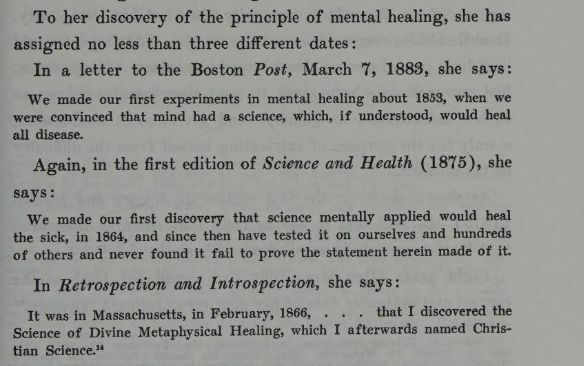
That autumn of 1866, her father would die and this event would be the impetus for her sister to also cut Mary off. She was also quickly cut off from friends and acquaintances, as many felt she often wore out her welcome. There are some particularly damming accounts of her behavior at this time that paint a very different picture from what Mary’s narrative is. We wont get into them here, suffice to say that Mary seemed to expect others to pay her special attention while she verbally abused them and did not pay her rents.
Stuck bouncing around boarding houses, Mary would teach her spiritual healing ideas to anyone who would listen. Mostly this ended up being Spiritualists, which she later would deny ever having been involved with.
She had a habit of claiming that she was spiritually superior to others and could only be possessed by Jesus or the Apostles. Apparently Mary didn’t care too much about blasphemy in these circles. She spent a long time treading on the goodwill of many Spiritualists who were duped by her, and they often found themselves being forced to endure long lectures about Quimby and his “science”.
In 1868 she began advertising for her spiritual healing services, which would attract the attention of student Richard Kennedy. They entered into a three year agreement, something she likely insisted on as she had already failed with two previous students. Unlike these two other failed students, what would happen with Kennedy would set the stage for a pattern with Mary.
At this point, she mostly began leaving the healing services up to Kennedy while she would charge for classes and begin working on writing down her ideas. He was actually rather successful in his practice, perhaps surprisingly, and the account of his character was quite positive.
Thanks to his help, her classes would grow. As Kennedy practiced his healing arts on others, he would inevitably tell them about Mary and recommend to that they take a class to learn more. This would also bring a lot of negative attention from other Christians, who would claim she was a charlatan just practicing mesmerism.
As more patients and students would arrive, Mary would try to push these responsibilities off to Kennedy. And as more students arrived, the more negative attention they would get. A cycle that Mary desperately wanted to distance herself from but couldn’t.
Eventually though, in 1872, things would come to a head between her and Kennedy. She claims that she realized that the reason people were calling her methods mesmerism was because Kennedy would often “lay hands” on patients he was attempting to cure. While she tried to discourage him from doing so, it would put a strain on their relationship until Kennedy left.
Mary would then go on to distance herself from him by calling him a mesmerist and a “wicked boy.” It was also about this time that Mary would stop teaching for three years and dedicate herself entirely to writing a textbook on her theories.
Kennedy claims that they disagreed because he wanted her to stop making sweeping claims about Quimbism and it’s ability to heal everything. Things escalated when, in front of a bunch of his friends, Mary accused him of cheating at cards. He apparently went home that night and tore his contract with her up.

Also during this time, Mary took on a lot of students and sued a fair few of them. Usually because they were unable to pay the $300 tuition she was asking at the time. Or because they had a falling out and she would then claim they were using mesmerism, not her science. Honestly, at this point, Mary just seems out of control.
Finally though, 10 years after the Ice Incident, she would finally publish Science and Health (with key to the Scripture) – though it would gain the latter portion of the title a few years later. In it she teaches that matter isn’t real and that humans aren’t made up of matter either. The logic being that since God is spiritual, and humans were made in His image, then we are also pure spirit. Essentially trying to prove both Transcendentalism and Christianity true at the same time.
Mary would continue to tinker with the language of this book for several years. Many critics would criticize her for this, saying that if the book was divinely inspired wouldn’t God have gotten the language right the first time? Mary would defend herself by saying that she was looking for the right words to express her spiritual vision, which she claimed she understood better as time went by.
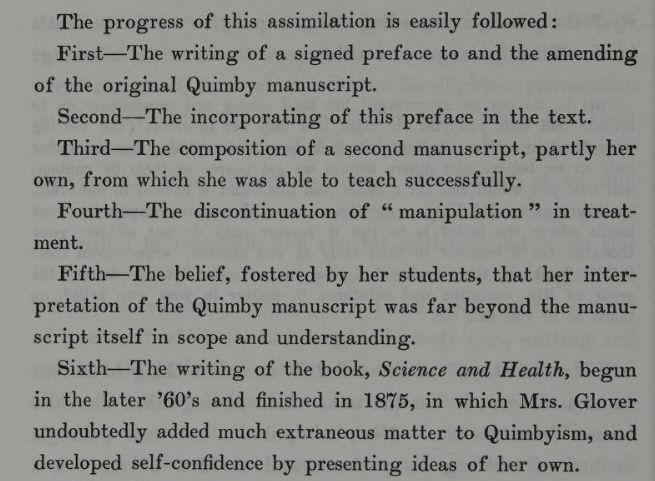
This also isn’t the only work that she continued to revise: remember in her early days she was working from her notes with Quimby. Until Science and Health was published, Mary spent considerable time teaching and revising those notes, but that’s a completely different story that I wont get into here. Just note that this is the period in which she began to remove any mention of “manipulation” or hands-on approaches to healing; this would later become her argument for why her Science is not mesmerism and how students could distinguish it from fakery.
It was noted that in Mary’s writing about malicious animal magnetism she would often point to Richard Kennedy. When their split happened, Mary formed a singular grudge against him. Often in describing malicious animal magnetism she would paint an awful picture of Kennedy. Just know that he would be her target for a long time before the concept became more broadly applied to just anyone that was against the movement.
We’ll delve more into the beliefs of Christian Science when we take a look at the faith and its structure. That said, I can’t emphasize enough how much Mary was the church. Or how much these beliefs in malicious animal magnetism would feed the ongoing drama she — and by extension the church — found herself in.
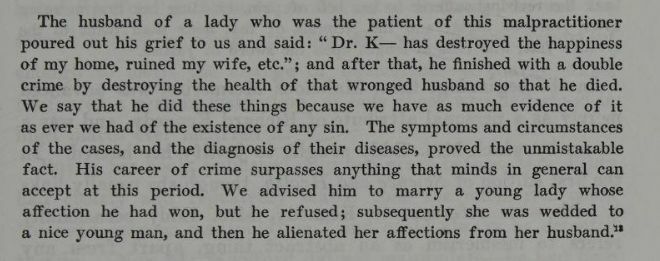
The next big moment in her life would be her marriage to her last husband. The Church claims that as the movement grew, Mary would meet her final husband among her students, Asa Gilbert Eddy. According to her, she had a violent seizure that he had revived her from, and from there it was love. They would marry on New Year’s Day 1877 and together would lead the emerging Christian Science Church. This is a fairly idyllic picture and other accounts describe what may have actually happened.

The story of how they met requires the entrance of Daniel Spofford. Spofford had initially acted as publisher for Science and Health when Mary had issues finding a first publisher for it. With the help of George Barry and Elizabeth Newhall, who both financed the project, he became one of the main promoters of the book.
Spofford was apparently so well liked that Mary had, allegedly, given him the pen she wrote Science and Health with. Barry, for his part, was the one who first called Mary “Mother.” They seemed to have a positive relationship at this time, unlike what had happened with Kennedy.
Eventually, he also became a teacher and practitioner – much like Kennedy before him. This would be during the time that Mary had largely locked herself away from teaching and was working on the second edition of Science and Health, much as she had done during Kennedy’s time.
This is also around the point that Christian Science as a term began to be used by her students. Spofford kept a record of his interactions with Mary and the other Christian Scientists, and around June 8 of 1875 is when we see this term first appear. In May — he, Barry, and one other student appointed themselves to a committee formed to help find a lecture hall for Mary to give public lectures in. On their June 8 meeting is when the rest of the group would officially recognize them and give themselves the group title of Christian Scientists.
Spofford had even been the reason Mary and Asa had met in the first place and he even helped arrange their wedding. Asa had a history of going to Spiritualist doctors in the past, and so when he moved to Lynn, MA, he went and sought the help of “Doctor” Spofford. Spofford convinced him to meet Mary and take her classes, so Asa went to one, and there Mary became instantly enamored with him.
Once they were married, and even just before that point, Mary would take to using Asa as an example of what a Christian Scientist ought to be. By paying Asa special attention and praising him constantly, other students became jealous, which caused Mary to say they were “draining her powers” so that she wasn’t able to work. She would constantly be missing around this time, usually with her new husband, under the guise that she needed respite from people needing her. This would be the beginning of a new pattern with Mary.
At the end of the print run for the first edition of Science and Health, Spofford had paid both Barry and Newhall some $600 for their contribution to its publishing. When she found out about this, Mary was indignant and upset that the money didn’t go to her, despite her never having entered into a royalty agreement for the first printing. All told, Barry and Newhall lost over $1500 in the venture, and Spofford had sunk about $500 into the cause.
No one made back their investment in the first edition. Spofford, rightfully so, was concerned about the next printing going much the same way.
So, while the two newlywed lovebirds were away in late 1877, Spofford would have a disagreement with Mary that would lead to a messy series of lawsuits for the Church. While getting things ready for the next edition, Spofford and Mary would have a disagreement over the publication terms.
Mary wanted a 25% royalty from the sales of each copy sold. Spofford replied that he didn’t see how they would cover printing and advertising costs if they did that.
Mary, behind Spofford’s back, rushed the second edition to print and in this edition was included a post-script that targeted Spofford in so many words. This is where she would describe a malicious mesmerism that didn’t require physical manipulation, and she would accuse Spofford of practicing it. This book, due to it being rushed, was far shorter than the edition that preceded it.
Still, this would mark the first time Mary began to describe evil in the world, which she had denied existed up until this point. She would go on to call this evil “Mortal Mind”, but ultimately it would mean the same thing as malicious animal magnetism. Anything bad that happens in the world can be attributed to Mortal Mind/Malicious Animal Magnetism.
Then suddenly in January of 1878, Spofford was kicked out of the Christian Science Association. All that was said was that he was being expelled for “immorality” and that he “was unworthy to be a member.” Essentially, she was saying that he wasn’t loyal to the church anymore. This was, for all intents and purposes, her way to call him an apostate/suppressive person/etc.
From here on, the new church would find itself embroiled in a series of lawsuits that would begin to drain their bank accounts.
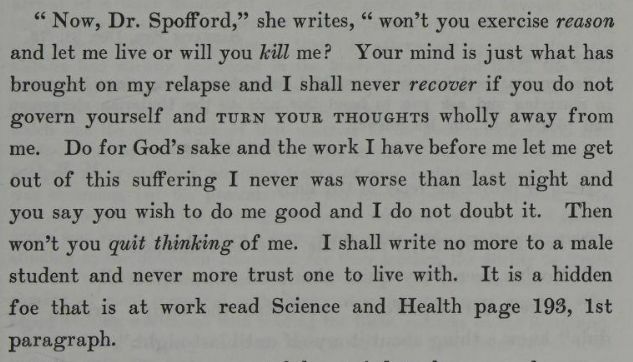
The Salem Trials
Now we come to the second Salem witch trial, so named because of what the lawsuit entailed and where it was heard.
Lucretia Brown, a student of Mary’s with a history of a spinal injury that she claimed Christian Science healed, sued Spofford for causing her to relapse through his malicious animal magnetism. While there is some debate about who crafted the lawsuit, it is widely speculated that Mary had a direct hand in helping Brown. Mary and the Church deny her involvement in it, but at least one witness came forward saying that at the least, Mary’s attorney – Edward Arens – drafted the complaint. Another account says that Arens was not the attorney in the case, but that since Mary’s original attorney did not want to argue the case, Arens was the one who took up the cause.
The lawsuit alleges the following:
- That Spofford is a mesmerist and is capable of using that skill to control the minds and bodies of others.
- In a three year span from 1875 to 1878, Spofford used his alleged abilities to cause injury to Brown in the form of spinal pain, neuralgia, and a “temporary suspension of the mind”.
- Brown fears that he will continue to harm her.
Though Spofford had been ordered to testify, he ultimately wouldn’t have to. His lawyer filed a demurrer – a document intended to challenge or object to a plea from an opposing party – and claimed that the court not only had no jurisdiction in the case, but also that there could be no remedy. Arens asserted that “mesmerism was an acknowledged fact” and challenged the demurrer.
This would prove ineffective as the Judge agreed with the demurrer, stating that even if Spofford were imprisoned, it wouldn’t prevent further harm. The case was dismissed, Brown tried to appeal, and the appeal was also dismissed.
A fitting end to a silly trial.

From 1877 to 1879 Mary would find herself in a number of lawsuits. Some of the highlights are:
- Barry finally sued her for $2700 for everything that he did for her and the publishing of Science and Health. This dragged on from 1877 till 1879, when the judge awarded him $395 plus interest from when he filed his motion.
- In 1878 she sued Kennedy for a $750 promissory note. It became a fight about how much instruction did Mary actually provide, and initially the court decided in Mary’s favor. It was then taken to a Superior Court and the jury there overturned the ruling, instead ruling in Kennedy’s favor.
- In that same year is when she would sue Spofford and other students for royalties she thought she was owed because of their practices. Two of the cases were decided in the favor of the students, and the one against Spofford was dismissed.
Then, in October of 1878, is when Asa and Arens would be arrested on conspiracy charges to murder Spofford. This is a wild story, so buckle up.
One day, a man named Sargent arrives at Spofford’s practice and tells him that two men Sargent was unfamiliar with wanted him dead. He goes on to say that they had hired Sargent to do the deed but he just wanted money out of them.
Both Sargent and Spofford told the local police about it and — shock and awe — the police decide to actually investigate it. The three – Sargent, Spofford, and the police detective — devised a plan for Spofford to disappear so that they could find and detain the actual perpetrators. Just like in detective stories.
While Spofford was safely hidden away, Sargent would identify Asa and Arens as the two who paid him to kill Spofford. They were taken into custody and held on a bail of $3000. Sargent had been paid $200 of an alleged $500 Asa and Arens had promised him.
Sargent testified that he and Arens had initially conceived the plan to send Spofford away, under the guise that Sargent needed Spofford to heal a sick child. The plan from there, according to Sargent, was to hit Spofford over the head so hard that he passed out and then tie him up in the reins of a runaway horse, so that it appeared that his death was an accident.
There were several witnesses who testified to either having seen Arens with Sargent or to having heard of the plan from Sargent. Two detectives involved in the case also testified to seeing Sargent at the Eddy’s home. The amount of evidence the prosecution had on their side led the case to be tried in a Superior Court in December of that year.
Ultimately the court, despite indicting both Arens and Asa, did not take up the case as the prosecution decided to not pursue it any longer. No reason was given. In a 1905 follow-up, the attorney in the case did not have any records of why the prosecution chose to stop. Mary essentially maintains that even this was the work of Kennedy and Spofford using malicious mesmerism to turn minds against her.
This was the high point of Mary’s obsession and paranoia over malicious animal magnetism. It had grown to the point where she believed that her communications with students were being intercepted by mesmerist agents. Messages had to be mailed secretly since Mary believed that even the USPS had been “enveloped in mesmerism.”
Everything in her life became consumed with these evil mesmerists who were out to get her in every way imaginable. They turned housekeepers and maids against her, students against her, and eventually the whole town of Lynn was against her thanks to the thoughts of Kennedy and Spofford. Even Asa himself, who was caught in his own fear of these people, began to displease Mary and she too accused the malicious mesmerists for this.
Then, at the end of their patience with Mary, eight students would leave, claiming that they were tired of her “love of money and the appearance of hypocrisy.”
Many of her most dedicated students had grown tired of her obsession with this malicious animal magnetism. Together they drafted and signed a resignation, then presented it to Mary at their next meeting. Mary was indignant and blamed, you guessed it, mesmerists for getting to them.
She then tried to see them individually, which failed as none of them wanted to discuss anything further with her. Still, refusing to accept that they (and several others after them) had resigned, she instead threatened them with expulsion. Either way, the damage was done, and any goodwill she had in Lynn had finally dried up.
Demoralized, she and Asa would leave for Boston and establish the Massachusetts Metaphysical College. It was established under a questionable charter that allowed them to hand out nonsense degrees. The college didn’t have a regular building either; instead it largely existed wherever Mary did. At best, she had hung a sign outside her home that declared it to be the Massachusetts Metaphysical College and I suppose under the aforementioned charter, that was enough to make it so.
An interesting side-note: This “college” gave out degrees of C.S.B, C.S.D, or D.S.D. I didn’t see any explanation of what these “degrees” really meant, but it was a funny note that people actually would use these to give themselves titles of doctor. Kind of like how PhD’s will often go around calling themselves Doctor to make it sound like they have expert medical knowledge.
It wouldn’t be that long after their move that Asa would suddenly become ill. Within a few months, he would be dead. Doctors diagnosed him with heart disease and later confirmed that diagnosis with an autopsy; a failed aortic valve and calcium deposits being the ultimate cause.
Mary, however, had a different idea. In a press conference she announced that he had been killed due to malicious animal magnetism, and that Christian Science could have saved him if it had been used in time. She also claimed that Arens was the one responsible for her husband’s unfortunate end, claiming that he had used “mental arsenic” to poison him.
Arens had moved with them to Boston and set up his own practice, where he printed his own pamphlet of metaphysics that heavily borrowed from Science and Health and mixed it with his own ideas. He also painted a through-line of the method from Jesus to Quimby, with some minor deference to Mary. Mary, obviously, didn’t like that and in the third edition of Science and Health included a preface written by Asa that denounced Arens as a plagiarist.
From that point onward, Mary claimed that Arens (like Kennedy and Spofford before him) was a malicious mesmerist whose effect on her was “like arsenic”. Which ties us back into why she thought he killed her husband.
Side Note: This is probably the wildest thing from Asa’s death. According to the account in The Life of Mary Baker G Eddy, Asa had willed his family farm to Mary when he died. She then sold it to a neighbor for $1,500. Now, that would’ve been a lot then, but as a Millenial I’m weeping on the inside.
Despite all this, and the negative press Mary had been getting, the church continued to grow. By 1885 they had enough members that leading Christian ministries began holding lectures where they condemned Mary’s ideas as blasphemous, saying that Christian Science was a dangerous innovation. Still, more and more students would take her classes and with her Christian Science Journal publication pumping out plenty of good press for her, the Church had expanded across the US and into Canada.
I’m skipping over so many things at this point now, mostly because they largely have to do with the Church itself and Mary by proxy. This has already been overly long and if I include the other lawsuits and dramatics of her life, we’ll be here all day. We’ll get into some of these when we talk about the Church. All I want to impart at this point is that hopefully, by now, you’ve realized just how much Mary is the Church and the Church is Mary.
Then, in 1889, she would shut it all down. She resigned as pastor, closed the Massachusetts Metaphysical College, and dismantled the Christian Science Association. She moved back to New Hampshire, settled into a quiet country life, and largely remained there – save for a brief stint in Boston in 1891 – until she moved to Concord, MA before her death.
But before she could die, she would have one final meeting with her only son, George Glover. Remember him from the beginning?
Well, in 1907 he went out to see her in Pleasant View, the name of the house she was living in at Concord. By this point, he claims that she was so incoherent and so delusional that she needed help. He filed a suit against prominent church members; alleging that Mary was too incompetent to manage her estate, that a receiver of her property should be appointed, and that the named defendants be required to detail their alleged misuse of her property.
This was brought up because Mary had implied that one of the leading church members wanted her to account for every penny spent. Thinking that his mother was being taken advantage of, George did what he thought was right to protect her. Can’t really blame him for trying.
Six days later, Mary declared a trusteeship for the control of her estate and George dropped his suit.
Mary died of pneumonia in 1910. There isn’t much more to say about it, really. By this point she would’ve been 89 and it would’ve been difficult for her to recover, with or without medical intervention. There is some debate on if she did accept morphine or had a morphine addiction by this point, but that is largely the realm of speculation and I couldn’t find anything to support this.
In all, Mary’s life was filled with dramatics and people constantly trying to validate her. This isn’t to paint her as a villain, though many may find her to be one. To me, Mary was a vain person who, lost out in the greater world, struggled to not only make sense of it but to get by in it. Receiving special attention from Quimby and then her students only fueled her on in the story she was telling about her life.
I don’t believe that Mary ever set out to make a religion, at least not in earnest. Had she, I don’t think she would’ve risked her reputation as much as she did during the lawsuits. It was largely due to people’s desperation to find healing that the movement took off, in my view, and its likely that without her students traveling the world the Church would not have survived. Distance from their teacher and her shenanigans is what kept it all from collapsing.
Next time, we’ll go over the history of the Christian Science organization. From inception, through each internal rift, and how it managed to survive the death of its leader. If we’re lucky, we’ll even get to talk briefly about the Manual of the Mother Church and how Mary had intended the organization to be run.
Until next time, however, stay safe and sane out there!
Further Reading:
- Williams, J. K. (1997). The Christian Scientists. Franklin Watts New York. https://archive.org/details/christianscienti00will/mode/1up
- Cater, W. (1993). The Life of Mary Baker G. Eddy and the History of Christian Science. University of Nebraska Press. https://archive.org/details/lifeofmarybakerg0000cath
- Gill, G. (1998). Mary Baker Eddy. Perseus Books. https://archive.org/details/marybakereddyrad00gill
- Eddy, M. B. (2002) Mary Baker Eddy: Speaking for Herself. Writings of Mary Baker Eddy. https://archive.org/details/marybakereddyspe00eddy
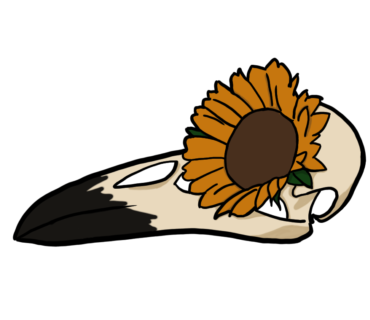
Leave a Reply
Only people in my network can comment.